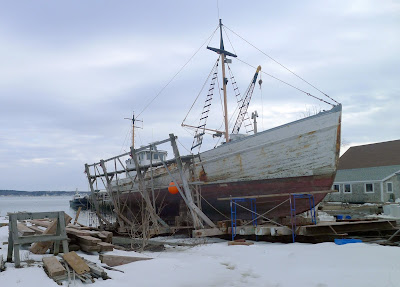 |
|
More Work than They Bargained For (Isaac H. Evans), Carol L. Douglas
|
Yesterday, my friend and erstwhile student took his wife and me out to breakfast. On the way home, I asked them to swing by the
North End Shipyard so I could ground myself in my next boat painting. He and I walked around the
Jacob Pikeconsidering the angles from which I could paint it. Since it’s in the cradle on a marine railway, those angles are limited to where there’s actual earth on which to stand.
His wife kept saying, “Over here, guys.” We politely ignored her; after all, she’s not a painter.
He took a call. I walked back over to where she was standing. “See?” she asked. And I did, and how. Artists are not the only people with eyes.
 |
|
Packing Oakum (Isaac H. Evans), Carol L. Douglas
|
I am reading the Bible with a friend who is a newer Christian. We were talking about how the Bible ignores the race questions that seem to consume us today. I referred to that soaring passage that reads, “There is neither Jew nor Greek, there is neither slave nor free, there is no male and female, for you are all one in Christ Jesus.” (Galatians 3:28)
The distinction between Jew and Greek wasn’t a race thing, it was a culture thing, I said.
“Yeah,” she answered. “One god versus many gods.”
Bam! It wasn’t what I’d meant; it was far more insightful than that. It was exactly how a first-century Jew would have seen the divide.
 |
|
Ready to Launch (Mercantile), Carol L. Douglas
|
I get lots of offers for ways to promote myself. I usually just delete them without opening. I spent this past week with
Bobbi Heath and listened as she sorted through the same detritus. She pokes her head into every rabbit hole and asks herself what she might be able to do with this new tool. Before Bobbi was an artist, she had a very successful career as a software project manager. There’s a lot to learn from her.
Each time we are challenged by a new idea, we face a choice. We can ignore it, get mad, or consider it. These moments are so common that we often miss them completely. We’re completely wrapped up in our own thoughts.
But each human being is the sum of his or her experiences, education, and character, which makes the potential for new thinking almost limitless. Creativity is about synthesizing existing ideas into new patterns. It’s hard for me to shut up sometimes, but when I choose to listen instead of talk, I learn a great deal.










